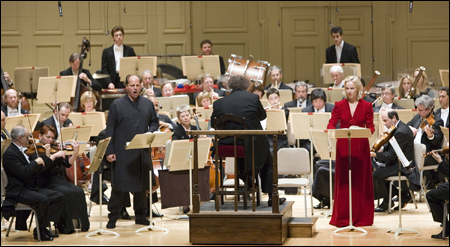
DUKE BLUEBEARD’S CASTLE: Demanding and haunting. |
What can be more exciting — or more unpredictable — than a live performance? Earlier this month the Boston Symphony Orchestra under James Levine played one piece twice, surrounding the Beethoven and Schoenberg violin concertos with repeat performances of Levine’s own string-orchestra arrangement of Beethoven’s monumental and monumentally challenging Grosse Fuge (the “Great Fugue,” Opus 133), originally the last movement of the Opus 130 string quartet. Hearing this a second time so illuminated — and was illuminated by — everything that had come before, I needed to hear the entire concert again.
But on Tuesday, something had gone awry. The Grosse Fuge had lost its focus. Crucial elements were missing: the progression of unfolding emotions from section to section, the way individual phrases were expressively shaped. Three dimensions had been flattened to one.
Then after the two concertos, the Grosse Fuge was back on target. Here was the moving, intense, shaped performance I had heard — twice — five days earlier. Why had the first Tuesday performance gone flat? Had the performers forgotten what they’d done after a lapse of several days, with no rehearsal in between? Was everyone just tired? (This has already been one of the most demanding BSO seasons in decades.) And did the first “run-through” energize rather than exhaust the players? Had they been reinspired by the thoughtful and astonishing Christian Tetzlaff’s playing of the two violin concertos?
A second hearing of the Schoenberg concerto also altered my view of that piece. I’d found it enjoyable to listen to but difficult to follow. Further acquaintance with any piece allows one to hear more easily how it fits together, however. On Thursday I’d felt a kind of carnival atmosphere; now I was struck by the heroic nature of this piece, how much larger in conception it was than I’d given it credit for, and therefore sadder, more moving, more powerful.
Or had the performance itself become more stirring?
The following week afforded the orchestra no respite. As if all the recent Schoenberg — some of it new to the BSO — weren’t demanding enough, the players had to deal with Béla Bartók’s early (1911) one-act opera Duke Bluebeard’s Castle, with its dazzling orchestrations mirroring the moody atmosphere of the Béla Balázs libretto, Bartók’s supersaturated color depicting the glittering treasury, fluttering garden, distant vistas (“silken meadows, velvet forests”), muted tears, and blood behind the duke’s locked doors. The players seemed to be having a field day. At times, it was hard to hear Anne Sofie von Otter (as Bluebeard’s latest wife, Judith) over the rich sound spectrum. Although she’s an intelligent, sensitive actress and vocalist, her voice doesn’t have the cutting edge this role requires. (No problem when she’s miked for a recording.) Bass-baritone Albert Dohmen, memorable in previous BSO Beethoven (Ninth Symphony) and Schoenberg (Gurrelieder), has precisely that kind of voice, a glinting surface radiating from an impenetrably dark timbre. Several reviewers criticized him for a certain inexpressivity. “If he envisioned the duke as an automaton, then he did a creditable job,” New York Sun critic Fred Kirshnit wrote about the Carnegie Hall performance. I thought Dohmen had, in fact, made a deliberate choice not to be melodramatic and found his restraint compelling, Bluebeard becoming increasingly passive as his inquisitive new wife insists on reopening his past.